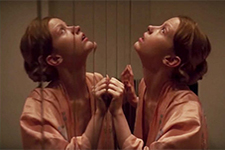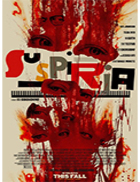Suspiria (2018)
|  Luca Guadagnino’s Suspiria, a remake of Dario Argento’s garish and grisly classic of operatic supernatural horror, does not lack in ambition or intensity, and there are parts of it that work with a marvelous and unsettling sense of physicality and heightened sensation. Guadagnino (I Am Love, Call Me by Your Name) is an intently tactile director with an intuitive sense of the connections between the physical, the spiritual, and the emotional, and in its best moments Suspiria connects those diverse experiences with a sense of propulsive immediacy that is distinctly different from Argento’s more aesthetically grandiose and deliberately theatrical approach. It may be a remake of one of the most well-known of modern European horror films, but Guadagnino makes it his own. Unfortunately, making it his own also entails a number of significant changes, including packing the narrative with an overt political history that never really coheres with the dramatic narrative and its distinctly feminine horrors (especially surrounding motherhood). Screenwriter David Kajganich (who wrote Guadagnino’s 2015 film A Bigger Splash) moves the story to West Berlin in 1977 (the year Argento’s film was released) and places its central location, a dance academy, right across the street from the Berlin Wall. The “divided Berlin,” as an on-screen title card refers to it, is a grim and dreary place fraught with political tensions, violence, and terrorism. Throughout the film we are reminded that this is the so-called “German Autumn,” defined largely by the bombings and kidnappings of the far-left militant Red Army Faction (RAF, also known as the Baader-Meinhof Gang) and the unfolding crisis following Palestinian terrorists hijacking a Lufthansa airliner and demanding the release of its leaders from a German prison. There is also a major subplot involving a character whose Jewish wife disappeared during the Holocaust, thus adding an additional layer of historical atrocity and guilt. And, had Kajganich and Guadagnino found a more robust way to interweave the historical and political horrors with the story’s supernatural horrors, they might have achieved something genuinely remarkable; instead, the political issues swirl around in the background, providing an urgent sense of time and place, but only as backdrop. There is little connection between the violence in the street and the twisted maternal violence that unfolds behind the dance academy’s imposing concrete façade, which means that the film feels torn, pitted against itself in its efforts to simultaneously engage real history, high drama, and horror. Perhaps there are ways to connect the dots and draw out genuine significance with multiple viewings, but the initial screening feels disjointed and scattered—lots of interesting ideas in search of connective tissue. As with Argento’s film, the protagonist is a seemingly innocent young American dancer named Susie Bannion (Dakota Johnson), who is here given a vague backstory involving her strict Mennonite family in Ohio and a dying mother (Malgorzata Bela). Susie is drawn to the Markos Dance Academy, which has been re-envisioned not as a classical ballet studio, but rather a striking, avant-garde troupe overseen by imposing choreographer Madame Blanc (Tilda Swinton), who, along with the other middle-age women who run the academy, comprise a coven of witches. The coven’s leader is Helena Markos, who remains largely unseen, but whose name is constantly evoked. The dance academy comes to the attention of Dr. Josef Klemperer (who is also played, for inscrutable reasons, by Swinton in extensive prosthetics and make-up), an elderly psychiatrist who has been treating Patricia (Chloë Grace Moretz), one of the academy’s dancers who has become deeply paranoid and appears to have pieced together the truth about the coven. Dr. Klemperer’s wife (Jessica Harper, who played Susie in the original film) disappeared during the Holocaust, and he bears the burden of guilt because he may have been partially responsible and frustration at not knowing what really happened to her. As a doctor who witnessed firsthand the horrors of Nationalsozialismus, he doesn’t believe in witches or witchcraft; but, if there’s one thing that the horror genre consistently shows us, it is that doctors and scientists are always wrong in trying to explain the supernatural through the natural. Although the plot is overly long and drawn-out, Suspiria never really drags, mostly because Guadagnino keeps it intensely physical and remarkably tangible. He and cinematographer Sayombhu Mukdeeprom (who also shot Call Me by Your Name) make this version visually distinct from Argento’s masterpiece of high style and garish Technicolor. Guadagnino instead literalizes the German Autumn with an emphasis on chilly desaturation; the horrors of his film unfold in a world of grays and browns in which perpetual rainfall gives way only to snow. The film’s sound design team deserves immense credit, as the soundtrack is awash in both effectively abstract atmospheric noise (lots of whispering and murmuring) and intensified naturalistic sound (page turning and pen scribbling are almost overwhelming at times). Similarly, the film’s dance sequences are notable not so much for the beauty or effectiveness of the choreography (which is often edited so heavily we can’t actually follow it), but rather its incessant emphasis on physical collision, particularly the dancers’ feet and hands slamming onto the floor and the accompanying explosions of breath. The choreography is furious, violent even, with intense and sudden movements that eschew grace in favor of speed and power, and we feel the rush of air around the dancers’ bodies. Thus, it is no surprise that the film’s most notable moment of horror is a dance sequence in which the witches use Susie’s movements to inflict violence on the body of another dancer, Olga (Elena Fokina), who has discovered their secret and is trying to leave the academy. Suddenly blinded and trapped in a mirrored dance studio, Olga’s body is thrown about with each of Susie’s moves, her bones cracking, her internal organs rupturing, her limbs twisting in horrible parodies of a dancer’s lithe flexibility. It is a fascinatingly grandiose sequence of true body horror, and it is the pinnacle of Guadagnino’s achievement in reimagining Argento’s film. And it has absolutely nothing to do with the German Autumn. Copyright © 2018 James Kendrick Thoughts? E-mail James Kendrick All images copyright © Amazon Studios |
Overall Rating: 

 (2.5)
(2.5)


